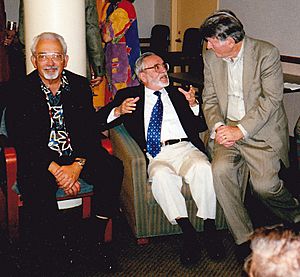Salvador Minuchin facts for kids
Quick facts for kids
Salvador Minuchin
|
|
|---|---|
| Born | October 13, 1921 San Salvador, Entre Ríos, Argentina
|
| Died | October 30, 2017 (aged 96) Boca Raton, Florida, United States
|
| Known for | Structural family therapy |
Salvador Minuchin (born October 13, 1921 – died October 30, 2017) was a special kind of therapist. He was born and grew up in San Salvador, Entre Ríos, Argentina. He created a way of helping families called structural family therapy.
This therapy looks at how family members connect with each other. It also looks at the "rules" and "boundaries" within a family. A therapist using this method tries to help families change unhealthy ways of interacting. The goal is to help them find healthier ways to live together.
Contents
Minuchin's Career Journey
Salvador Minuchin first worked as a doctor in the Israeli army. After that, he went to New York City to learn about helping children with mental health issues. He trained with a famous doctor named Nathan Ackerman.
Later, Minuchin went back to Israel to help children who had lost their homes. In 1954, he returned to the United States. He continued his training in a type of therapy called psychoanalysis.
After his training, Minuchin worked at a school for troubled boys. This is where he realized that helping whole families could make a big difference.
Developing Family Therapy
While at the school, Minuchin and his co-workers started developing a new way to do family therapy. They would have one therapist work with a family. Other therapists would watch through a special one-way mirror. This helped them all learn from each other.
This new way of working led Minuchin to create structural family therapy. In 1962, he went to Palo Alto to work with another therapist, Jay Haley. Minuchin's work at the school also led to his first book, Families of the Slums (1967). This book explained his new ideas about family therapy.
Minuchin also taught and guided other therapists, like Esther Perel and Virginia Goldner.
In 1965, Minuchin became the director of a clinic in Philadelphia. He later focused on training other therapists there until 1981. Then, he moved to New York to continue his work. In 1996, he retired in Boston. Salvador Minuchin passed away on October 30, 2017, in Boca Raton, Florida.
Friendship with Jay Haley
Minuchin and Jay Haley became good friends and worked together. Minuchin once said that Haley was his most important teacher. He described Haley as someone who always pushed new ideas and challenged him.
Minuchin compared their friendship to Spock and Captain Kirk from Star Trek. He said Jay Haley was very intellectual, while he himself was more practical.
Minuchin's Ideas About Family Therapy
Salvador Minuchin made big contributions to how we understand families. His most important idea was structural family therapy.
When he started, Minuchin talked about two types of families:
- Enmeshed families: These families are very close, sometimes too close. It can be hard for family members to have their own space or ideas.
- Disengaged families: These families are not very close. Members might feel distant from each other and not share much.
Minuchin believed that families often try to solve problems with small, simple changes. He called these "first-order changes." But for a family to truly become healthier, bigger changes are needed. He called these "second-order changes." These changes involve altering the basic rules and ways the family works.
Helping Families with Eating Challenges
In 1978, Minuchin helped write a book called Psychosomatic Families: Anorexia Nervosa in Context. This book looked at how families could help treat anorexia nervosa. Anorexia nervosa is a serious eating challenge.
The book explained that family therapy can be a very helpful part of treatment. It showed how understanding family connections can help people get better. The book also shared stories of families who successfully used this approach.
Minuchin's Thoughts on Other Therapy Styles
Minuchin also shared his thoughts on other types of family therapy. He felt that some newer therapies, while good in some ways, missed important things. He believed therapists should be active and help families connect more. He thought therapy should focus directly on solving a family's problems and reducing their stress.
Minuchin Center for the Family
When Minuchin moved to New York in 1981, he started the Family Studies Institute. Here, he taught other family therapists. He also worked with foster care systems to help children and families.
After Minuchin retired in 1995, the center was renamed the Minuchin Center for the Family. It continues to teach his ideas about structural family therapy. The center also helps organizations that work with families facing challenges like poverty or unfair treatment.
Selected Works
Books
- with Braulio Montalvo; Bernard G. Guerney, Jr.; Bernice L. Rosman,; Florence Schumer, Families of the Slums. New York: Basic Books, 1967.
- The Disorganized and Disadvantaged Family: Structure and Process (1967)
- Psychoanalytic Therapies and the Low Socioeconomic Population (1968)
- Families and Family Therapy. Cambridge, Massachusetts: Harvard University Press, 1974.
- with B. Rosman, B. & L. Baker. Psychosomatic Families: Anorexia Nervosa in Context. Cambridge, Massachusetts: Harvard University Press, 1978.
- with H. C. Fishman. Family Therapy Techniques. Cambridge, Massachusetts: Harvard University Press, 2004.
- with Michael P. Nichols; 'Family Healing Strategies for Hope and Understanding' New York, NY: The Free Press, 1998.
Articles
- "Where is the family in narrative family therapy?" The Journal of Marital and Family Therapy, vol. 24, 397-403. (1998)
- "Retelling, reimagining, and re-searching: A continuing conversation". The Journal of Marital and Family Therapy, vol. 25, 9-14. (1999)
- "Jay Haley: My Teacher". Family Process, vol. 46, 413-414. (2007)
See also
 In Spanish: Salvador Minuchin para niños
In Spanish: Salvador Minuchin para niños


